Storia dell’Ordine della Mercede e il Convento
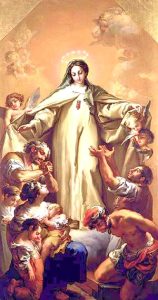
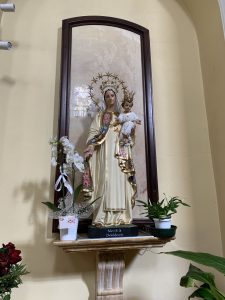
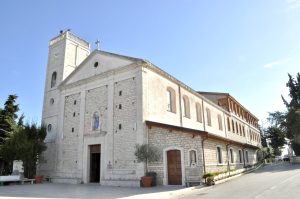
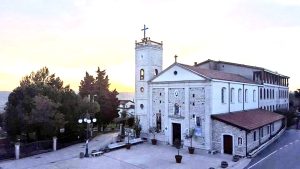

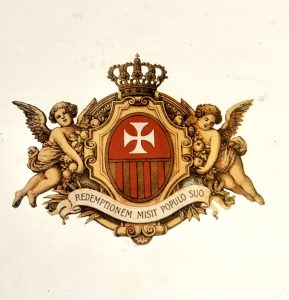

Parrocchia Santuario Maria SS. di Carpignano
L’Ordine dei Mercedari
Il Convento di Carpignano
San Pietro Nolasco
Lo stemma dell’Ordine

Parish Sanctuary Maria SS. of CarpignanoThe Order of the MercedaryThe Convent of Carpignano
San Pietro Nolasco
The coat of the Order
L’Ordine dei Mercedari
L’Ordine di S. Maria della Mercede fu fondato a Barcellona il 10 agosto 1218, da Pietro Nolasco, con lo scopo di liberare i prigionieri cristiani ridotti in schiavitù dai musulmani o dai pagani e poi approvato, il 17 gennaio 1235, da papa Gregorio IX che impose ai religiosi la regola di Sant’Agostino come norma fondamentale. Inizialmente, l’ordine ebbe carattere laicale e militare ma nel tempo acquisì caratteristiche più spirituali, tanto che nel 1690 si inserì tra gli ordini mendicanti. Dopo l’abolizione della schiavitù, i Mercedari si dedicarono all’insegnamento e all’apostolato missionario: dopo il concilio Vaticano II, in virtù dello spirito del fondatore, i frati ripresero a contrastare le nuove forme di schiavitù di carattere politico, sociale e psicologico, secondo il principio “LIBERI PER LIBERARE”, ovvero liberare l’uomo di ogni tempo dalle schiavitù, specialmente quelle pericolose per la fede cristiana.
Il Carisma e la spiritualità dell’Ordine
Il Prologo delle Costituzioni del 1272, nell’istituire l’Ordine, stabiliva che i Mercedari avrebbero dovuto ispirarsi ai principi di mantenimento e sviluppo della misericordia mediante la visita e la redenzione dei cristiani caduti nel potere dei saraceni e di altri contrari alla Legge di Cristo, vivendo come figli di una vera obbedienza, sempre gioiosamente disposti a dare la loro vita, se necessario, come Gesù Cristo la diede per l’umanità. L’opera della redenzione mercedaria ha anche lo scopo di rincuorare gli schiavi nella loro sventura e ridare la speranza agli abbandonati e ai disperati, aspetto questo non indifferente dell’azione redentrice dei Mercedari. Le Costituzioni del 1986, nei numeri 13-16, così si esprimono: “Seguendo San Pietro Nolasco e illuminati dal suo carisma, noi Mercedari crediamo che la nostra missione liberatrice appartiene alla natura stessa dell’Ordine e la esercitiamo in nome della Chiesa in intima comunione con Dio e in una reale incarnazione nelle necessità degli uomini. Per compiere questa missione, spinti dalla carità, ci consacriamo a Dio con un voto particolare in virtù del quale promettiamo di dare la vita, se necessario, come Cristo l’ha data per noi, per salvare i cristiani che si trovano nell’estremo pericolo di perdere la loro fede nelle nuove forme di schiavitù. Questo voto, assunto come promessa volontaria, cosciente e assoluta, è caratteristico del nostro Ordine, ispira tutti gli atti della sua opera e qualifica l’adempimento della sua missione nella Chiesa”.
Nuove forme di schiavitù possono riscontrarsi in una situazione sociale che comprenda le seguenti condizioni: –sia oppressiva e degradante per la persona umana;
derivi da principi e sistemi opposti al Vangelo; ponga in pericolo la fede dei cristiani; offra la possibilità di aiutare, visitare e redimere le persone che si trovano in tale situazione.
Il messaggio del Capitolo Generale celebrato nel maggio 1998 ha offerto particolari riflessioni sul tema di Cristo Redentore, maestro e modello del Mercedario di oggi, come lo fu per i Mercedari di ieri, specialmente per S. Pietro Nolasco.
Il Convento di Carpignano
Fondatore della comunità mercedaria carpignanese fu P. Adolfo Londei, primo superiore della comunità.
Egli giunse a Carpignano nel febbraio 1901, insieme a fr. Ferdinando Bandiera e a P. Antonio Giuliano.
Nei primi tempi i due abitarono in una casetta situata sulla destra della chiesa, poi, una volta decisa la costituzione di una nuova comunità, avviarono i lavori per il nuovo convento. La prima pietra fu benedetta il 17 maggio 1902 e i lavori si conclusero nel 1907.
La costruzione, l’ampliamento e il restauro sia del convento sia della chiesa continueranno nel corso degli anni fino ai giorni nostri, grazie all’interessamento e alla determinazione dei vari parroci e Superiori che si sono succeduti negli anni. L’arrivo dei Padri Mercedari a Carpignano ha contribuito notevolmente allo sviluppo sociale e religioso locale.
Nel 1920, i Mercedari aprirono una prima scuola per analfabeti che prevedeva ben due turni, uno serale e l’altro mattutino.
Nel dopoguerra fu inaugurato un secondo ciclo di scuole elementari delle classi IV e V e, successivamente, con l’ultimazione della struttura del convento, si avviò la Scuola Apostolica dell’Ordine e la formazione di nuovi insegnanti, innalzando notevolmente il livello culturale locale.
Notevole fu anche il loro contributo per la dotazione della linea elettrica a Carpignano, da quel momento luogo anche di ritrovo e di aggregazione sportiva per la presenza di spazi verdi e, nel tempo, di campi sportivi nel grande parco del convento.
In tale fermento religioso e sociale, moltissime, infine, furono le vocazioni fra i giovani irpini.
S. Pietro Nolasco
Pietro Nolasco nacque e visse nel contesto medievale di Barcellona, in particolare nel suo porto marittimo, ove svolse, fin da giovane, il lavoro di mercante ereditato dal padre.
Nel suo contatto con il porto di Barcellona e con le rive del Mediterraneo, egli scoprì la piaga della schiavitù che toccò profondamente il suo cuore tanto da imbarcarsi per mare con l’intento di redimere gli schiavi, investendo direttamente i suoi beni e coinvolgendo numerosi amici.
Questo piccolo gruppo divenne poi, il 10 agosto del 1218, un vero e proprio ordine religioso e le case della Mercede sorsero in tutto il sud della Francia, in Catalogna, a Maiorca, a Valencia, ad Aragona e a Castiglia, portando il messaggio di libertà non solo per le strade polverose della penisola ma attraverso tutto il Mediterraneo.
Nel 1235, Papa Gregorio IX confermò l’Ordine con la bolla Devotionis vestrae. Il pellegrinaggio terreno di Pietro Nolasco ebbe termine a Barcellona, nel suo convento costruito nell’arenile di Villanova, vicino al mare, il 6 maggio 1245. La Congregazione dei Riti ne approvò il culto immemoriale il 30 settembre 1628, e il 19 giugno 1655 il suo nome fu inserito nel Martirologio Romano. L’11 giugno 1664, Papa Alessandro VII estese il suo culto a tutta la Chiesa.
Lo stemma dell’Ordine
Lo stemma rappresenta il segno distintivo del religioso appartenente all’Ordine della Beata Maria Vergine della Mercede, da sempre portato al petto dei frati come lasciapassare sin dalle loro prime missioni redentrici.
Gli elementi fondamentali che lo costituiscono sono lo scudo e lo stemma di Giacomo I d’Aragona.
Lo scudo, recante la croce bianca che campeggia sullo sfondo rosso, rappresenta la croce della cattedrale di Barcellona che il vescovo Berenguer de Palou donò quando nacque la fraternità dell’Hospitalis di S. Eulalia (cf. Bulla Devotionis Vestrae…, Perugia 17 gennaio 1235). Lo stemma di Giacomo I di Aragona, d’oro a quattro pali di rosso, testimonia il patronato e la benevolenza della casa reale spagnola all’Ordine. Questo patronato reale alla missione redentrice dell’Ordine permetteva ai frati della Mercede di tutti i tempi, dal XIII al XVIII secolo, un rispettoso andirivieni oltre le frontiere durante le missioni redentrici, vale a dire lungo i difficili itinerari, al fine di riscattare coloro che erano caduti in prigionia dei Saraceni.
A cura dei Padri Mercedari
The order of the Mercedary
The Order of “S. Maria della Mercede”was founded in Barcelona on 10th August 1218 by Pietro Nolasco with the aim of freeing Christian prisoners enslaved by Muslims or pagans and then approved on 17th January 1235 by Pope Gregory IX who assigned the rule of St. Augustine to the religious as a fundamental rule. Initially the order had a secular and military character, then it became more spiritual, arriving in 1690 to be included among the mendicant orders. After the elimination of slavery, the Mercedaries dedicated themselves to the teaching and the missionary apostolate: after the Second Vatican Council, by virtue of the founder’s spirit, the friars resumed opposing the new forms of political social and psychological slavery, according to the principle LIBERI PER LIBERARE that is to free man of all times from slaveries, especially those dangerous for the Christian faith.
The Charism and spirituality of the Order
The Prologue of the Constitutions of 1272, in setting up the Order, established that the Mercedaries should be inspired by the principles of maintenance and development of mercy through the visit and redemption of Christians who have fallen into the power of the Saracens and others contrary to the Law of Christ, living as children of true obedience, always joyfully willing to give their life, if necessary, as Jesus Christ gave it for humanity. The work of Mercedary redemption also has the purpose of encouraging slaves in their misfortune and restoring hope to the abandoned and desperate, a not indifferent aspect of the redemptive action of the Mercedaries. The 1986 Constitutions, in numbers 13-16, express themselves as follows: “Following St. Peter Nolasco and enlightened by his charisma, we Mercedaries believe that our liberating mission belongs to the very nature of the Order and we exercise it in the name of the Church in intimate communion with God and in a real incarnation in the needs of men. To carry out this mission, driven by charity, we consecrate ourselves to God with a particular vow by virtue of which we promise to give our life, if necessary, as Christ gave it for us, to save Christians who are in extreme danger to lose their faith in the new forms of slavery. This vow, taken as a voluntary, conscious and absolute promise, is characteristic of our Order, it inspires all the acts of its work and qualifies the fulfillment of its mission in the Church”.
The new forms of slavery are found where a social situation occurs which includes the following conditions: – it is oppressive and degrading for the human person; it derives from principles and systems opposed to the Gospel; it endangers the faith of Christians; it offers the possibility of helping, visiting and redeeming people who find themselves in such a situation. The message of the General Chapter celebrated in May 1998 offered particular reflections on the theme of Christ the Redeemer, teacher and model of today’s Mercedary, as it was for yesterday’s Mercedaries, especially St. Peter Nolasco.
The Convent of Carpignano
Father Adolfo Londei, the first superior of the community, was the founder of the Carpignano mercedary community. He arrived in Carpignano in February 1901, together with Father Ferdinando Bandiera and Father Antonio Giuliano.
In the early days they lived in a small house located on the right of the church, then, once the constitution of a new community was decided, they began the construction of the new convent. The first stone was blessed on May 17th 1902 and the works were completed in 1907.
The construction, expansion and restoration of both the convent and the church will continue over the years to the present day, thanks to the interest and the determination of the various pastors and Superiors who have succeeded one another over the years. The arrival of the Mercedary Fathers in Carpignano contributed significantly to social development and local religious.
In 1920, the Mercedaries opened a first school for the illiterate which included two shifts, one in the evening and the other in the morning.
After the war, a second cycle of elementary schools of classes IV and V was inaugurated and,
subsequently, with the completion of the convent structure, the school started Apostolic of the Order and the training of new teachers, significantly raising the local cultural level.
Their contribution was also noteworthy for the provision of the power line in Carpignano, from
that moment also a place of meeting and sporting aggregation due to the presence of green spaces
and, over time, of sports fields in the large park of the convent.
Finally, in this religious and social ferment, there were many vocations among Irpini young people.
S. Pietro Nolasco
Pietro Nolasco was born and lived in the medieval context of Barcelona and, in particular, in its seaport where, from an early age, he carried out the work of a merchant inherited from his father.
In his contact with the port of Barcelona and with the shores of the Mediterranean he discovered the scourge of slavery that will forever touch his heart so much that he embarked by sea with the intent of redeeming the slaves by investing his goods directly and also involving his friends.
This community will become a religious order on August 10th 1218 and the houses of La Mercede were built throughout the south of France, in Catalonia, in Mallorca, in Valencia, in Aragon and in Castile, bringing the message of freedom not only to the dusty streets. of the Peninsula but across the Mediterranean.
In 1235 Pope Gregory IX confirmed the Order with the bull Devotionis vestrae.
His earthly pilgrimage ended in Barcelona, in his convent built on the beach of Villanova, near the sea, on May 6th 1245.
The Congregation of Rites approved its immemorial cult on 30th September 1628, and on 19th June 1655 its name was inserted in the Roman Martyrology. Pope Alexander VII extended his cult to the whole Church on 11th June 1664.
The coat of arms of the Order
It is the distinctive sign of the religious belonging to the Order of the Blessed Virgin Mary of Mercy, the friars have always worn it on their chest as a pass along the first centuries in their redemptive missions.
The fundamental elements are the shield and the coat of arms of James I of Aragon.
The shield, bearing the white cross that stands out on the red background, represents the cross of the cathedral of Barcelona that the bishop Berenguer de Palou donated when the fraternity of the Hospitalis of St. Eulalia was born (cf. Bulla Devotionis Vestrae …, Perugia 17th January 1235).
The coat of arms of James I of Aragon, in gold with four red poles, testifies to the patronage and benevolence of the Spanish royal house to the Order. This royal patronage of the redemptive mission of the Order allowed the friars of Mercede of all times, from the 13th to the 18th century, a respectful coming and going beyond the borders during the redemptive missions, that is to say along the difficult itineraries, in order to redeem those who had fallen into the captivity of the Saracens.
By the Mercedary Fathers
